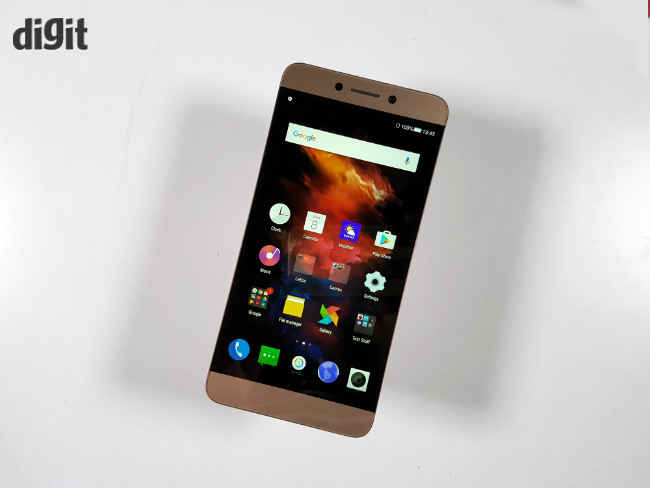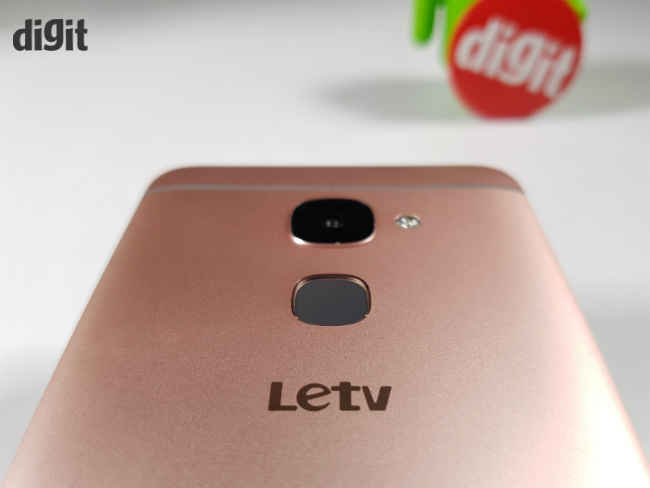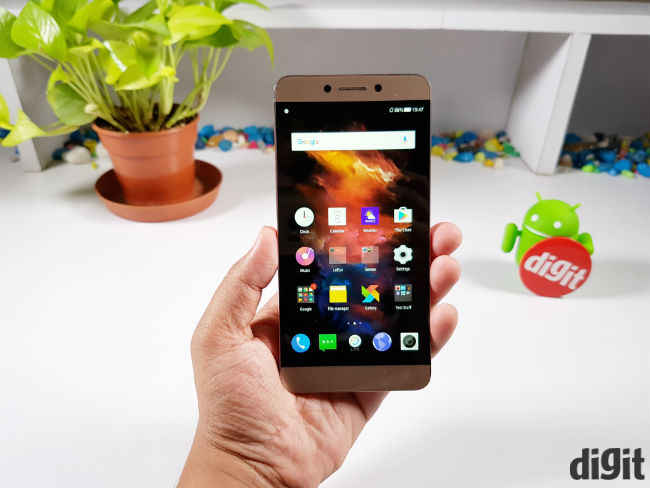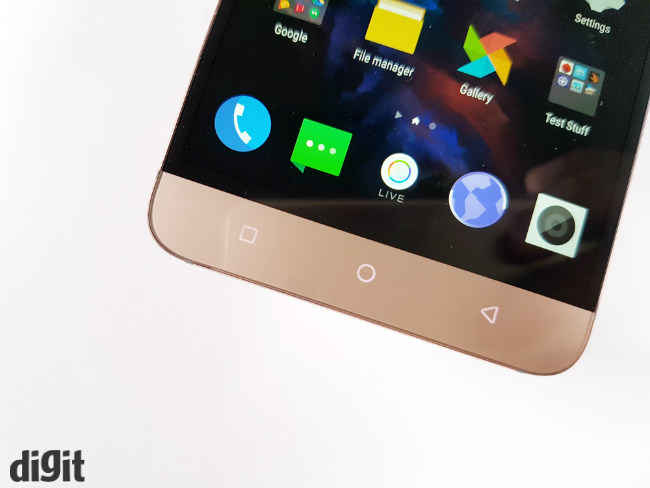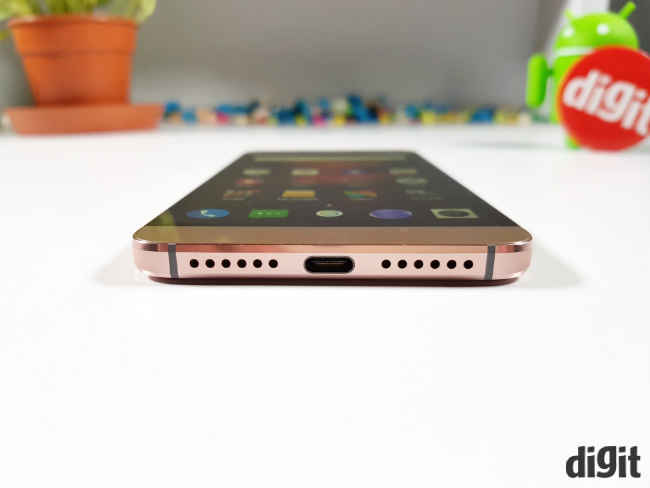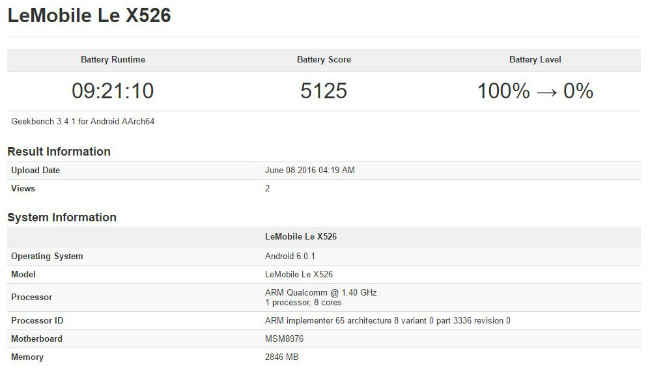LeEco Le 2 review: The Next Prodigy
LeEco's Le 2 smartphone offers smooth performance, lossless audio interface, a good display and an overall smooth build. The battery backup and camera are not the best, but it still dethrones the Xiaomi Redmi Note 3 to become the best budget smartphone for now.
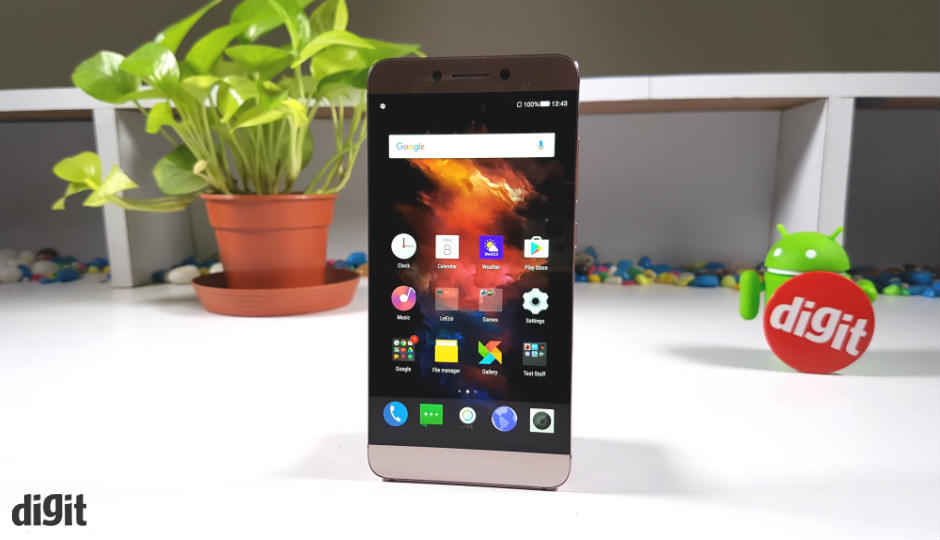
Digit Rating: 87/100
 Survey
SurveyPros
Sublime performance
Good colour reproduction on display
Lossless audio is a start
Well-built, good looking
Incredible value for money
Cons
Not the best battery life
Camera renders too much noise
Verdict
The LeEco Le 2 is an admirable smartphone. It brings great performance to the table, thanks to the Snapdragon 652 SoC and 3GB of RAM. It also provides a good display, decent build and ergonomics, and the CDLA technology is a positive step for the future of smartphone audio. The Xiaomi Redmi Note 3 still provides better battery backup, and the Moto G4 Plus has the best camera in the sub-15k price bracket. However, the LeEco Le 2 is the best overall smartphone, and a price of Rs. 11,999 offers unparalleled value for your money. If you are looking for a smartphone now, the LeEco Le 2 is a great smartphone to recommend.
Introduction
When LeEco launched the Le 1s in India, it created a decent round of impressions among the Indian audience. The smartphone had a standard design that was implemented well, offered a good display panel, reasonably decent performance, and most importantly, a strong value proposition among buyers. In fact, until Xiaomi introduced the Qualcomm Snapdragon 650-powered Redmi Note 3 in India, the LeEco Le 1s was among the prime recommendations in the budget segment. It still is, but just not at the top.
With the Le 2, LeEco will be looking to snatch the baton back from Xiaomi’s hands. In terms of specifications, the LeEco Le 2 is powered by the Qualcomm Snapdragon 652 SoC, comprising four ARM Cortex-A72 cores and four Cortex-A53 cores, with an overall peak clock speed of 1.8GHz. It also houses 3GB of RAM, along with 32GB of non-expandable internal storage. A 3000mAh non-removable Li-Po battery powers the setup, which has a 5.5-inch IPS LCD display with 1080×1920-pixel resolution. The Le 2 uses the Adreno 510 GPU, alongside getting the efficiency of Qualcomm’s Hexagon 680 DSP and the X8 LTE modem. LeEco has used a 16-megapixel Omnivision OV16880 PureCel sensor in the primary camera, with 1mi pixel size. It gets a 5-element, f/2.0 lens, along with phase detection autofocus and digital image stabilisation. The 8-megapixel OmniVision OV8865 front camera is coupled with a f/2.2, wide angle lens. The Le 2 runs on Android Marshmallow v6.0.1, with eUI 5.6 custom ROM. Amidst all of this, the Le 2 has also introduced Continual Digital Lossless Audio (CDLA), a proprietary audio transmission technology that uses the USB-C interface to drive audio tracks to headphones with more power, higher bit rate (owing to faster data transfer) and lesser signal noise, thereby providing high resolution, nearly lossless audio.
For a smartphone priced at Rs. 11,999, the LeEco Le 2 presents a formidable package on paper. However, scenarios are often different in real life usage. Does the LeEco Le 2 live up to its venerable specifications sheet? Find out here, in our LeEco Le 2 review.
Build, Design and Aesthetics
The LeEco Le 2 is reminiscent of its predecessor. The Rose Gold variant I have here has a uniform metal body that feels reassuring. The display takes up 74.6 percent of the front area, thereby leading to a reasonably ergonomic build and form factor. It is crucial to remind you here that one-handed usage will be tricky, owing to the 5.5-inch display panel, but the Le 2 does not feel as ‘large’ (with the emphasis) as, say, a Xiaomi Redmi Note 3. Furthermore, the slightly chipped edges along the side rim attempt to not make the device dig into your palm. It is still very upright and rigid, but is not as sharp as it would have been without the chipped edges.
Against the smooth matte metal chassis, the chipped edges pose a shiny finish, thereby adding to the smartphone’s looks. It’s not revolutionary, but adds an element of finesse to the device. LeEco has done away with the 3.5mm analogue audio port, and the Le 2 houses only one I/O port, the USB-C housed at the bottom panel of the smartphone. Six-pore speaker grilles flank it on either side, with the volume rocker and the power/unlock button to the right. The button response is satisfying, with a satisfying feedback notifying you of the click. The fingerprint sensor is housed on the rear panel, right underneath the camera module. The fingerprint sensor bypasses the lock screen and directly unlocks the device, and you would find yourself using the power button sparingly. The fingerprint sensor is accurate, but not the fastest around. It recognises your fingerprint in about 0.4 seconds, which is not exactly slow, but feels considerably slower than Android’s integrated Imprint fingerprint identification. It is comparable to Apple’s Touch ID, which itself is not the fastest standard.
Overall, the device feels well built, and makes for a pleasant start to my LeEco Le 2 review. While there is nothing really exceptional to talk about in its design, the LeEco Le 2 looks suave, and has a simplistic approach to it. The chipped edges add to its ergonomics, which is somewhat compromised by the large display panel. It still feels good to hold, but the metal chassis means that the grip is somewhat compromised. That, though, does not significantly defer its position as one of the more well-built devices in the sub-20k price bracket of smartphones in India.
Display and UI
The LeEco Le 2 packs in a Full HD, IPS LCD display panel. A resolution of 1080×1920 pixels on 5.5-inch display panel has been an accepted standard of late, and the Le 2 excels here with the depth of colours reproduced on it. By default, the display’s Colour Mode is set to ‘LeEco’, which renders the display’s colour temperature on the cooler side, at around 3600K. Setting it to ‘Natural’ wields the colour temperature to around 5600K, which makes the overall display look much better.
The Le 2’s display panel is pleasant to look at, while being sharp and rich in colour detail. The blacks look deep, the whites are bright, the overall hue is on the neutral end of warmth in colour temperature scale, all of which combines to make this display a good display panel to watch content on. The Corning Gorilla Glass 4 screen protection is layered smoothly on top of the display panel, and the overall touch response is fluid. The smartphone is zippy with regular settings and browsing, and the fluent touch response of the display aids in its quest.
The display also provides sharp contrast ratios, and selecting Video Display Enhancement in Settings will marginally spike up the saturation level, which, in addition to the warmth of the display’s neutral settings, combine to make it comfortable to watch on. The only con here is the brightness level. While it does suffice when you are indoors, taking it outdoors on a bright, sunny Wednesday morning affirms the lack of brightness in comparison to the likes of Xiaomi’s Sunlight Display technology. Adding to the slightly low brightness level is the reflective surface of the display, and sunlight viewing is not particularly enjoyable here. Unless it was an email (which generally appears with a white background and bold, black text), I somewhat struggled to decipher content on the Le 2’s display. Apart from this, a very enjoyable display.
LeEco’s eUI 5.6 is aeons different from stock Android appearance. There is no app drawer, the drop-down notifications panel will read only your latest notifications, while quick settings and closing of apps are fused into one screen that can be accessed with one tap of the capacitive multitasking button. All of the capacitive buttons are backlit, which is a boon. I personally like the neat, uncluttered feel of LeEco’s eUI, and the interface is responsive enough for smooth, fluid operations. It will take you only a few hours to figure out eUI’s details, and the learning curve is a neat, uncomplicated one.
LeEco also pre-installs a suite of applications, namely LeView, Live and LeVidi. LeView shows up on a Blinkfeed/Spotlight-like panel on the panel to the extreme left, showing a curated list of stories, videos and other content to watch from across various websites. Live is placed where the traditional app drawer’s icon would have been, and opens up LeEco’s suite of live television content that you can watch. LeVidi brings premium video content from Eros Now, YuppTV and Hungama. All of these apps are integrated seamlessly into the interface, and actually feels like a part of the entire ecosystem. The good display panel also encourages content viewing, and the applications’ layouts are in synchronisation with the rest of the interface. Job well done for LeEco here.
Performance
The octa-core Snapdragon 652 SoC, coupled with 3GB of RAM, Adreno 510 GPU, X8 LTE modem, Hexagon 680 DSP and 32GB of storage are integrated well, and are closely comparable with the performance output of the Vivo V3 Max. The octa-core chipset keeps two A53 cores on sleep, unless all of the eight cores come into action in High Performance Mode. The Hexagon 680 DSP takes care of background applications with ease, and even when you play a graphics and processor-intensive game as Modern Combat 5 or Asphalt Airborne, there are no notable stutters to the smartphone.
As we had explained in the difference between the Xiaomi Redmi Note 3’s Snapdragon 650 and this Snapdragon 652 SoC, the LeEco Le 2 is as close to the flagship-class Snapdragon 820 as you would have hoped for. Take for instance, switching between data and WiFi is not as seamless as on a Snapdragon 820-powered device (the Mi 5). The graphics rendered on the LeEco Le 2 are crisp, smooth and fluid, but there is a noticeable difference between the Adreno 530 and Adreno 510, where the Adreno 510 renders lesser frame rates, and the smartphone often takes half a second more to open a menu or a Settings option. LeEco’s eUI attempts to mask this with smooth animations, but it really shows. The UI, though, is thankfully less taxing on the processor, which enables the entire system to work seamlessly when you are browsing through multiple Google Chrome pages, wish to instantly switch to Live and tune in to Al Jazeera, simultaneously respond to emails, and with a couple of apps running on the background. All of this works seamlessly, and thanks to the Hexagon DSP, the Snapdragon 652 SoC can keep essential apps running in the background and render games with highly playable graphics and ample smoothness.
While all of this does tax heavily on battery, the Le 2 still delivers sublime performance, particularly considering its pricing. It is possibly one of the smoothest smartphones in this price bracket, if not, the best in terms of performance in this price bracket. Even across benchmarks, the LeEco Le 2 set the limit in AnTuTu’s 3D Bench test, 3DMark’s Unlimited physics and graphics test, and even the Geekbench 3 multi-core performance test. These scores, attached in the graph below, reflect on its everyday performance, which is highly impressive.
Camera
The LeEco Le 2 uses Omnivision’s 2015 image sensor, the OV16880, with 1mi pixel size. This 16-megapixel image sensor renders reasonably true-to-source colour details, alongside preserving sharpness and saturation levels in photographs in brightly lit environments. The level of details is not among the best, and there is a slight sense of grain, even at ISO 200 under direct sunlight.
The richness of colours is preserved without majorly spiking up the vibrance and saturation levels. In low light situations, the Le 2 does well to preserve close-to-accurate colour details, but the level of noise ruins subject sharpness and details. The Le 2 also does well with the overall colour levels of the entire frame, with shadows being deep but not overtly dark. The only qualm here is the lack of details and sharpness of subject, a major deterrent in the camera’s performance.
The LeEco Le 2’s camera app is reasonably smooth, and like the rest of the interface, uncluttered. It also allows you to use the fingerprint sensor as a shutter button for both the rear and front cameras, in which case it is a tad too response, often leading to me accidentally taking snapshots that I hastily scurried to delete. The phase detection autofocus is smooth, fast and responsive. It may not be the fastest camera module around, but fast enough to hastily snap fleeting moments. Unfortunately, though, it does not feature optical image stabilisation, as a result of which photos shot on the move end up being mostly blurry.
There is, however, something that is not absolutely fluent about the Le 2’s camera. The colours and contrast levels that the camera renders are satisfying, but the lack of sharpness and high noise levels somewhat ruin the colour details. The overall response is reasonably fluid, but the split-second lag that the camera takes to initiate, along with the time taken to save the photographs, bog it down slightly. The camera is satisfactory at best, and the photographs will best serve you for social media sharing with post-processing. It is, however, not exceptional. View the photograph samples here, for details.
Continual Digital Lossless Audio (CDLA)
LeEco has come up with its proprietary lossless audio standard that it intends to establish via USB-C port-powered headphones. It has introduced a pair of in-ear headphones that comply with CDLA standards, priced at Rs. 1,990. The company will be hoping that the standard is adopted more widely, and has a lot of reason to expect that. For one, the USB-C port increases the rate of data being transferred to the headphone, facilitating playback of heavier, lossless tracks.
Additionally, the CDLA technology drastically decreases signal-to-noise ratio, delivering cleaner audio tracks alongside the higher fidelity of audio. It can also power the noise cancellation circuitry housed in CDLA-enabled headphones to deliver noise cancellation through these. This derivation of power allows the headphones to work with more power, owing to the amplifier and digital-analogue converter (DAC) housed within the headphone circuit. While all of these sound excellent for all audiophiles, we will really need to wait for USB-C headphones with CDLA to make the most of this technology. As of now, the smartphone misses a 3.5mm port, and uses the USB-C port with an adapter to be compatible with most headphones. This is mildly inconvenient, as the Le 2 cannot be put on charge when audio is being played, and vice versa. Additionally, the presence of the analogue audio port essentially negates the goodness of CDLA for all standard headphones. You may not notice anything right away, but it is a peg for the future to improve the quality of infotainment on smartphones.
Battery Life
On benchmark, the LeEco Le 2 lasted for 9 hours, 21 minutes and 10 seconds, scoring 5125 on Geekbench 3. This is a fair reflection of the Le 2’s real life battery stamina, which is reasonably decent with low intensity usage, but certainly not among the best. With 20-25 emails, about 150 WhatsApp and Messenger chats, 20 minutes of YouTube streaming, 30 minutes of racing on Asphalt Airborne and 15 more minutes of news broadcast on BBC World via LeLive, the Le 2’s charge went down from 68 percent to 11 percent in 4 hours and 45 minutes. A major factor to consider here is that I spent most of my time with the display on at full brightness.
The device charged from 11 percent to 96 percent, or by 85 percent, in 42 minutes, which is quite fast. The LeEco Le 2 supports Fast Charging 2.0, and it does charge fast, indeed. With the usage specified above and comparatively lesser screen-on time, expect the LeEco Le 2 to last for about 10 to 11 hours at best, which is not exactly the best battery life to provide. It may see you through your average day at work, but for a smartphone aimed at entertainment consumption, a more extensive battery life is craved.
Bottomline
The LeEco Le 2 may not have the best battery backup and camera in the segment, but both are manageable, unless either or both are absolute priorities. What it excels at is sheer performance, a delightfully rich display, a smooth, functional UI, and most importantly, the value proposition that it brings. The LeEco Le 2 is, in my opinion, the better looker between itself and the Xiaomi Redmi Note 3. It packs in a slightly better display in terms of colour richness (although the Redmi Note 3 delivers better brightness), is marginally but noticeably faster than it, and only falls behind in battery life. Considering everything, at Rs. 11,999, we are looking at the best budget smartphone of now. Period. However, you can consider the Xiaomi Redmi Note3 if battery life is your priority, and the Moto G4 Plus if you crave for a better camera.
The LeEco Le 2 is indeed the next prodigy, seemingly set to upset the Xiaomi Redmi Note 3’s crown.
